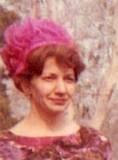In June one sunny year after graduating from high school, feeling betrayed by my high school friend Julius who asked me to dance who then laughed as I stood up and said, "Do you really think I would dance with you?", I boarded a train to San Francisco at Clinton, Iowa, sailed past Treasure Island after studying postcards of movie stars and eventually visited the homes of celebrities along the green tree-lined hilltops of Santa Catalina Island.
I saved my money from weed-salvaging and corn-detassling to pay for my transportation. Dad gave me a healthy allowance for my work in the farm fields.
Mother and Dad saw me off on the train, waved slowly, tears of pride shining from their eyes.
Aunt Miranda couldn't join us to the station, she was in a wheel chair with a crocheted shawl drawn across her knees, but she smiled brightly and pressed a green velvet ribbon into my hand, green, she once told me for prosperity and hope.
Aunt Miranda once told me the best advice she could give me was to look everyone straight in the eye, to answer truthfully, and to smile slightly. Every problem can be interpreted in terms of three, she once told me. Three primary colors, red, blue and yellow. Three in religion, father, son, and Holy Ghost, and three in ourselves, past, present, and future. Think in terms of three and you will find your way in life, she once told me.
Symbols of childhood raced across my eyes, thoughts of mother as she ironed my dresses in the morning before school and prepared my lunch with great care and of Dad who took me to town for ice cream when it rained in the summer fields.
After several weeks work in my uncle's store, I returned home briefly with hat and gloves as I was trained to do after completing finishing school to be met with questions of where I might be from by local neighbors, and then when in San Francisco again, dressed as I was taught, meeting new questions of where I might be from.
At fifteen, I looked nineteen, rather plain, with a mind like a many-spoked wheel and several interests, each arrow pointing outward while moving to the next as the hands of a clock marked the time as though it never began and would be in tune with the universe forever.
Years later, when I lived in Pacific Heights in California facing a lovely view of the ocean I painted pictures and wrote poetry, worked part time for an engineering firm and attended some post-graduate classes through an extension division of U.C. Berkeley.
City life in San Francisco was not like riding horseback on the farm or wandering dreamily through the meadows in springtime seeking daffodils or baby yellow meadowlarks.
San Francisco, a favorite of dreaming idealists where diversified culture is accepted as casually as the brisk ocean fog, arguing seagulls and flocks of unwanted pigeons. One must remember to respect the saints, to attend religious services, and not to be surprised to learn some churches in San Francisco teach political theories instead of religion like on the farm communities of Wisconsin.
In Wisconsin, one can leave their screen door unlocked while visiting a neighbor for a cup of sugar, but in the city, one quickly learns the visitors are identified as pushovers by more experienced travelers and newcomers should try to remember their childhood training and not talk to strangers.
Based on a thesis about Watergate, I received a scholarship to the University of California at Berkeley, a prize I treasured almost more than the memories of a happy childhood on the Wisconsin farm.
At Berkeley, I studied nuclear physics, was told it was a secret, but children learn fast, and there is theater in most of us.
I hoped to continue to study music, paint, and create beautiful dreams for others to follow, to remember the best of the past and look forward to a bright future.
My teacher at U.C. Berkeley, Miss Virginia, met me at the Faculty Club as she promised, the exclusive building sheltered in a ravine behind a bridge, just hidden from view.
The walls of the campus dormitory of Cheney Hall were brightly painted with diagonal lines. The Museum of Art was a delight to the eye with large sculptured rectangles, as though placed from above, resting on one another in perfect balance, with the sunlight gleaming through in afternoon glory. Brightly colored paintings by Hans Hoffman greeted visitors, abstracts, pen and ink drawings, and molded chairs were placed facing each other side by side, as though conversations were just completed.
Who walked these halls, where are they now, the artists, teachers, and attorneys? Are they crying, are they happy, did they learn while they were here? Will I find new friends here? Where is the bookstore? When will the campus bells ring?
While I was pondering the relationships between the arts and sciences and my good fortune at winning a scholarship, I recognized the outline of someone who resembled Julius and he walked over towards me.
But he was not Julius, although he resembled Julius. I thought of Julius everywhere and eventually learned to dance professionally and taught ballet and the Latin dances.
During early years in California, I met many surprising situations due to my perceived knowledge of nuclear physics, but I hoped that when the eventual opportunity presented itself, if I saw him, if he could dance, and if he asked me, I would say to Julius, "I would love to dance with you."
Thursday, January 29, 2009
Subscribe to:
Post Comments (Atom)

No comments:
Post a Comment